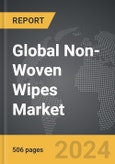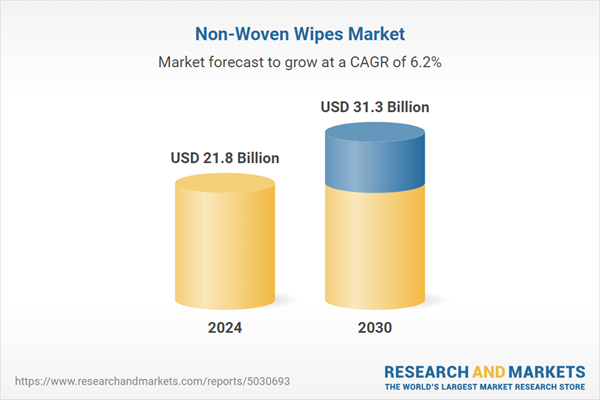The global market for Non-Woven Wipes was valued at US$21.8 Billion in 2024 and is projected to reach US$31.3 Billion by 2030, growing at a CAGR of 6.2% from 2024 to 2030. This comprehensive report provides an in-depth analysis of market trends, drivers, and forecasts, helping you make informed business decisions. The report includes the most recent global tariff developments and how they impact the Non-Woven Wipes market.
Non-woven wipes are made from diverse materials, each selected for particular traits like absorbency, durability, softness, and affordability. Materials are often blended to produce wipes that meet the exact needs of their intended application, considering factors like the purpose of use, desired strength, absorbency levels, and softness. Non-woven wipes are commonly used for personal hygiene, such as baby wipes and facial wipes, as well as for medical purposes, including disinfecting surfaces and wound care. The unique characteristics of non-woven wipes, such as their ability to trap and remove dirt and bacteria, make them indispensable in maintaining hygiene standards in various settings.
The demand for non-woven wipes has been steadily increasing, driven by advancements in non-woven fabric technology and the growing awareness of hygiene and cleanliness. Innovations in materials and production processes have led to the development of biodegradable and eco-friendly wipes, addressing environmental concerns associated with single-use products. Additionally, the COVID-19 pandemic has significantly boosted the use of non-woven wipes for sanitation and disinfection purposes, further accelerating market growth. The non-woven wipes market is driven by increasing awareness pertaining to hygiene and infection prevention, rising disposable income, availability over the online channel and surging demand for sustainable, biodegradable products made using recyclable options. Factors such as increasing health consciousness, changing lifestyles and expansion of the retail sector are poised to offer a significant growth stimulus to the market. The convenience and effectiveness of these wipes in maintaining hygiene have made them a staple in households, healthcare facilities, and commercial establishments. Moreover, the expanding applications of non-woven wipes in automotive, industrial, and food service sectors underscore their versatility and essential role in various industries.
The growth in the non-woven wipes market is driven by several factors. Technological advancements have enabled the production of wipes with enhanced features such as improved durability, higher absorbency, and better antimicrobial properties. The rising consumer preference for convenient and disposable hygiene products has fueled demand. This trend is particularly evident in the increasing use of baby wipes, personal care wipes, and household cleaning wipes. The heightened awareness of health and hygiene, spurred by global health crises like the COVID-19 pandemic, has led to a surge in the use of disinfecting wipes in both domestic and commercial environments. Rising popularity of specialty wipes for industrial and household applications along with increasing attention on renewable resources are poised to create new growth avenues for the global market. Additionally, the development of eco-friendly and biodegradable non-woven wipes is meeting the growing consumer demand for sustainable products. The expansion of distribution channels, including e-commerce platforms, has made non-woven wipes more accessible to a broader consumer base, further propelling market growth.
Segments: Material (Cellulose-based Fibers, Petroleum-based Materials, Specialty Fibers, Latex Binders); End-Use (Household Wipes, Baby Wipes, Industrial Wipes, Personal Care Wipes).
Geographic Regions/Countries: World; USA; Canada; Japan; China; Europe; France; Germany; Italy; UK; Spain; Russia; Rest of Europe; Asia-Pacific; Australia; India; South Korea; Rest of Asia-Pacific; Latin America; Argentina; Brazil; Mexico; Rest of Latin America; Middle East; Iran; Israel; Saudi Arabia; UAE; Rest of Middle East; Africa.
The analysts continuously track trade developments worldwide, drawing insights from leading global economists and over 200 industry and policy institutions, including think tanks, trade organizations, and national economic advisory bodies. This intelligence is integrated into forecasting models to provide timely, data-driven analysis of emerging risks and opportunities.
Global Non-Woven Wipes Market - Key Trends & Drivers Summarized
Non-woven wipes have emerged as a versatile and essential product in various industries, including healthcare, hygiene, and household cleaning. These wipes are produced through a manufacturing process that involves bonding fibers together to create a fabric-like material without weaving. This technique allows for the production of wipes with specific properties such as high absorbency, softness, and strength, which are crucial for different applications.Non-woven wipes are made from diverse materials, each selected for particular traits like absorbency, durability, softness, and affordability. Materials are often blended to produce wipes that meet the exact needs of their intended application, considering factors like the purpose of use, desired strength, absorbency levels, and softness. Non-woven wipes are commonly used for personal hygiene, such as baby wipes and facial wipes, as well as for medical purposes, including disinfecting surfaces and wound care. The unique characteristics of non-woven wipes, such as their ability to trap and remove dirt and bacteria, make them indispensable in maintaining hygiene standards in various settings.
The demand for non-woven wipes has been steadily increasing, driven by advancements in non-woven fabric technology and the growing awareness of hygiene and cleanliness. Innovations in materials and production processes have led to the development of biodegradable and eco-friendly wipes, addressing environmental concerns associated with single-use products. Additionally, the COVID-19 pandemic has significantly boosted the use of non-woven wipes for sanitation and disinfection purposes, further accelerating market growth. The non-woven wipes market is driven by increasing awareness pertaining to hygiene and infection prevention, rising disposable income, availability over the online channel and surging demand for sustainable, biodegradable products made using recyclable options. Factors such as increasing health consciousness, changing lifestyles and expansion of the retail sector are poised to offer a significant growth stimulus to the market. The convenience and effectiveness of these wipes in maintaining hygiene have made them a staple in households, healthcare facilities, and commercial establishments. Moreover, the expanding applications of non-woven wipes in automotive, industrial, and food service sectors underscore their versatility and essential role in various industries.
The growth in the non-woven wipes market is driven by several factors. Technological advancements have enabled the production of wipes with enhanced features such as improved durability, higher absorbency, and better antimicrobial properties. The rising consumer preference for convenient and disposable hygiene products has fueled demand. This trend is particularly evident in the increasing use of baby wipes, personal care wipes, and household cleaning wipes. The heightened awareness of health and hygiene, spurred by global health crises like the COVID-19 pandemic, has led to a surge in the use of disinfecting wipes in both domestic and commercial environments. Rising popularity of specialty wipes for industrial and household applications along with increasing attention on renewable resources are poised to create new growth avenues for the global market. Additionally, the development of eco-friendly and biodegradable non-woven wipes is meeting the growing consumer demand for sustainable products. The expansion of distribution channels, including e-commerce platforms, has made non-woven wipes more accessible to a broader consumer base, further propelling market growth.
Report Scope
The report analyzes the Non-Woven Wipes market, presented in terms of units. The analysis covers the key segments and geographic regions outlined below.Segments: Material (Cellulose-based Fibers, Petroleum-based Materials, Specialty Fibers, Latex Binders); End-Use (Household Wipes, Baby Wipes, Industrial Wipes, Personal Care Wipes).
Geographic Regions/Countries: World; USA; Canada; Japan; China; Europe; France; Germany; Italy; UK; Spain; Russia; Rest of Europe; Asia-Pacific; Australia; India; South Korea; Rest of Asia-Pacific; Latin America; Argentina; Brazil; Mexico; Rest of Latin America; Middle East; Iran; Israel; Saudi Arabia; UAE; Rest of Middle East; Africa.
Key Insights:
- Market Growth: Understand the significant growth trajectory of the Cellulose-based Fibers segment, which is expected to reach US$13.3 Billion by 2030 with a CAGR of a 7.3%. The Petroleum-based Materials segment is also set to grow at 6.2% CAGR over the analysis period.
- Regional Analysis: Gain insights into the U.S. market, valued at $6.5 Billion in 2024, and China, forecasted to grow at an impressive 8.5% CAGR to reach $3.6 Billion by 2030. Discover growth trends in other key regions, including Japan, Canada, Germany, and the Asia-Pacific.
Why You Should Buy This Report:
- Detailed Market Analysis: Access a thorough analysis of the Global Non-Woven Wipes Market, covering all major geographic regions and market segments.
- Competitive Insights: Get an overview of the competitive landscape, including the market presence of major players across different geographies.
- Future Trends and Drivers: Understand the key trends and drivers shaping the future of the Global Non-Woven Wipes Market.
- Actionable Insights: Benefit from actionable insights that can help you identify new revenue opportunities and make strategic business decisions.
Key Questions Answered:
- How is the Global Non-Woven Wipes Market expected to evolve by 2030?
- What are the main drivers and restraints affecting the market?
- Which market segments will grow the most over the forecast period?
- How will market shares for different regions and segments change by 2030?
- Who are the leading players in the market, and what are their prospects?
Report Features:
- Comprehensive Market Data: Independent analysis of annual sales and market forecasts in US$ Million from 2024 to 2030.
- In-Depth Regional Analysis: Detailed insights into key markets, including the U.S., China, Japan, Canada, Europe, Asia-Pacific, Latin America, Middle East, and Africa.
- Company Profiles: Coverage of players such as Asahi Kasei Corporation, Contec, Inc., Freudenberg Group, Glatfelter Corporation, Japan Vilene Company, Ltd. and more.
- Complimentary Updates: Receive free report updates for one year to keep you informed of the latest market developments.
Some of the 101 companies featured in this Non-Woven Wipes market report include:
- Asahi Kasei Corporation
- Contec, Inc.
- Freudenberg Group
- Glatfelter Corporation
- Japan Vilene Company, Ltd.
- Kimberly-Clark Worldwide, Inc.
- Nice-Pak Products, Inc.
- Reckitt Benckiser Group plc
- S. C. Johnson & Son, Inc.
- Texel Technical Materials, Inc.
- The Clorox Company
- Vernacare
Tariff Impact Analysis: Key Insights for 2025
Global tariff negotiations across 180+ countries are reshaping supply chains, costs, and competitiveness. This report reflects the latest developments as of April 2025 and incorporates forward-looking insights into the market outlook.The analysts continuously track trade developments worldwide, drawing insights from leading global economists and over 200 industry and policy institutions, including think tanks, trade organizations, and national economic advisory bodies. This intelligence is integrated into forecasting models to provide timely, data-driven analysis of emerging risks and opportunities.
What’s Included in This Edition:
- Tariff-adjusted market forecasts by region and segment
- Analysis of cost and supply chain implications by sourcing and trade exposure
- Strategic insights into geographic shifts
Buyers receive a free July 2025 update with:
- Finalized tariff impacts and new trade agreement effects
- Updated projections reflecting global sourcing and cost shifts
- Expanded country-specific coverage across the industry
Table of Contents
I. METHODOLOGYII. EXECUTIVE SUMMARY2. FOCUS ON SELECT PLAYERSIII. MARKET ANALYSISCANADAITALYSPAINRUSSIAREST OF EUROPESOUTH KOREAREST OF ASIA-PACIFICARGENTINABRAZILMEXICOREST OF LATIN AMERICAIRANISRAELSAUDI ARABIAUNITED ARAB EMIRATESREST OF MIDDLE EASTIV. COMPETITION
1. MARKET OVERVIEW
3. MARKET TRENDS & DRIVERS
4. GLOBAL MARKET PERSPECTIVE
UNITED STATES
JAPAN
CHINA
EUROPE
FRANCE
GERMANY
UNITED KINGDOM
ASIA-PACIFIC
AUSTRALIA
INDIA
LATIN AMERICA
MIDDLE EAST
AFRICA
Companies Mentioned (Partial List)
A selection of companies mentioned in this report includes, but is not limited to:
- Asahi Kasei Corporation
- Contec, Inc.
- Freudenberg Group
- Glatfelter Corporation
- Japan Vilene Company, Ltd.
- Kimberly-Clark Worldwide, Inc.
- Nice-Pak Products, Inc.
- Reckitt Benckiser Group plc
- S. C. Johnson & Son, Inc.
- Texel Technical Materials, Inc.
- The Clorox Company
- Vernacare
Table Information
| Report Attribute | Details |
|---|---|
| No. of Pages | 554 |
| Published | April 2025 |
| Forecast Period | 2024 - 2030 |
| Estimated Market Value ( USD | $ 21.8 Billion |
| Forecasted Market Value ( USD | $ 31.3 Billion |
| Compound Annual Growth Rate | 6.2% |
| Regions Covered | Global |









